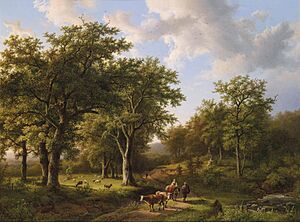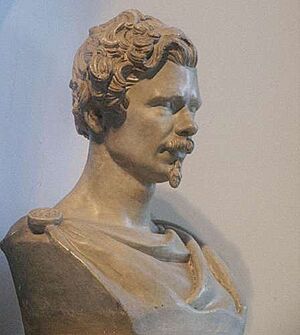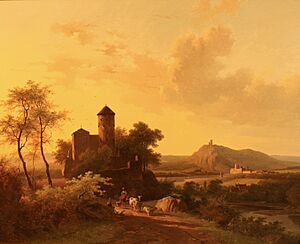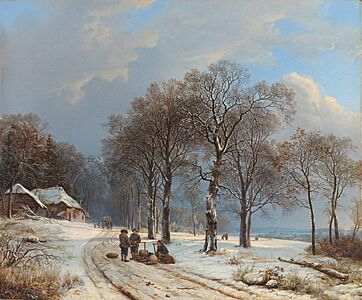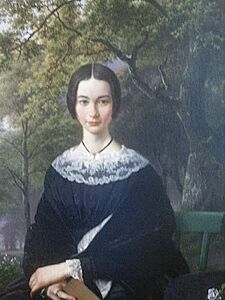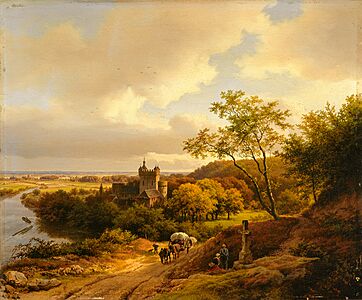Barend Cornelis Koekkoek facts for kids
Quick facts for kids
Barend Cornelis Koekkoek
|
|
|---|---|
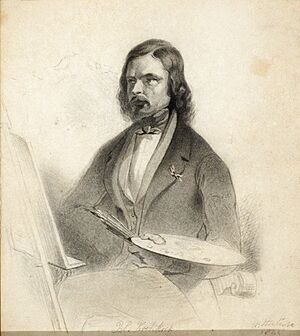
Koekkoek (1844)
|
|
| Born | October 11, 1803 Middelburg, Netherlands
|
| Died | April 5, 1862 (aged 58) Cleves, Germany
|
| Education | Abraham Krayestein |
| Known for | Landscape artist |
| Spouse(s) |
Elise Thérèse Koekkoek-Daiwaille
(m. 1833) |
Barend Cornelis Koekkoek (born October 11, 1803 – died April 5, 1862) was a famous Dutch landscape artist. He was also a lithographer, which means he made prints using a special stone or metal plate.
Contents
About Barend Cornelis Koekkoek
His Early Life and Family (1803–1824)
Barend Cornelis Koekkoek was born in Middelburg, a town in the Zeeland province of the Netherlands. He was born on October 11, 1803. His father, Johannes Hermanus Koekkoek, was a well-known painter of sea scenes. Barend learned a lot about art from his father.
Barend had three younger brothers: Hermanus Koekkoek, Johannes, and Marinus Adrianus Koekkoek. They all became successful artists too! Barend grew up surrounded by art.
He became known as the "Prince of Landscape Painting." People admired his beautiful landscape paintings. He is even called the founder of Dutch romantic landscape painting. Many important people bought his art. These included King Friedrich-Wilhelm IV of Prussia and King Willem II of the Netherlands.
In 1817, Barend started studying at the Drawing Academy of Middelburg. His teacher was Abraham Krayestein. Later, in 1822, he moved to Amsterdam. There, he studied at the Koninklijke Academie van Beeldende Kunsten for four years. By the time he was 19, he knew he wanted to paint landscapes.
Barend loved to paint large forests. He showed them in both summer and winter. He often painted tiny people in huge, grand natural settings. This showed how small humans are compared to nature's power. This idea was popular with other Romantic painters like Caspar David Friedrich.
Painting landscapes was a popular subject during the Dutch Golden Age. This period inspired many artists in the 1800s. Barend lived in Hilversum for two years (1826–1827). This area was home to many landscape painters. Living there helped him decide to focus on landscapes. His paintings from Hilversum were very popular. In 1829, he won a gold medal for one of his summer landscapes.
In 1833, Barend married Elise Thérèse Daiwaille. She was the daughter of his teacher and friend, Jean Augustin Daiwaille. They had five daughters. One of their daughters, Adèle, also became a painter.
His Art Career and Moving to Cleves
The flat countryside of the Netherlands was not exciting enough for Barend. He wrote in 1841 that his home country did not have "rocks, waterfalls, high mountains or romantic valleys." He wanted to paint grander nature scenes.
So, in 1834, he moved to Cleves, Germany. This old city was perfect for him. He found the beautiful landscapes he wanted to paint there. Soon, his paintings were full of large oak trees and winding paths. They showed wide views with amazing detail and a special mood.
Barend spent the rest of his life in Cleves. He painted his most important landscapes there. These included wide river valleys and peaceful forest views. Many of his paintings featured one or more large oak trees. He often made his trees look very dramatic. This helped show how small people are compared to nature.
By 1841, other artists looked up to Koekkoek. He decided to write a book for students. It was called Recollections and Communications of a Landscape Painter. In this book, he said that artists must always be true to nature. They should observe carefully and draw well. The book was like a journey along the Rhine River. It pointed out different parts of nature and landscapes.
In the same year, many young artists wanted to learn from him. So, Koekkoek started his own drawing academy. It was called the Zeichen Collegium. Many artists came to Cleves to learn from him. These included Frederik Marinus Kruseman and Johann Bernard Klombeck. These students followed Koekkoek's ideas. They created a style called 'Cleves Romanticism'. This style mixed real details with an ideal, dreamy feeling.
Koekkoek told his students to study nature closely. He advised them to watch how light changed at sunrise and sunset. He also told them to study how storms developed. He also taught them about the great Dutch painters from the 1600s.
The 1840s and 1850s were Koekkoek's best years. In 1859, he had a major stroke. This meant he could no longer paint. He passed away on April 5, 1862, in Cleves.
His Famous Paintings
Koekkoek's paintings show that he studied old Dutch masters very carefully. His art was inspired by great 17th-century painters. These included Meindert Hobbema, Cuyp, and Jacob Isaakszoon van Ruisdael.
His paintings often have a warm, golden light. They also include travelers. This shows he admired Dutch painters who were inspired by Italy. These artists were called the Bamboccianti.
Koekkoek believed his paintings were a mix of careful observation and artistic skill. He studied both art and nature very closely. He created beautiful landscapes that celebrated the wonder of nature. People still love Koekkoek's work today. They enjoy his lively paintings and the feeling of looking back to the past. He is still seen as the most talented landscape painter of Dutch Romanticism.
Haus Koekkoek in Cleves
Barend Koekkoek earned a lot of money from his art. In 1842, he bought land in downtown Cleves. Over the next seven years, he built a grand house there. It was designed in the Italianate style.
After he died in 1862, the house was sold. Most of his furniture was sold at an auction. In 1902, a German doctor bought the house. He added to it and changed the inside. He decorated it in the Art Nouveau style.
Luckily, the house was not badly damaged in World War II. After the war, it was used as the city hall for a few years. It also hosted art shows. In 1960, it became a museum for the city. In 1997, it was restored to look like an artist's home again.
- Haus Koekkoek, Cleves, Germany
More of His Works


